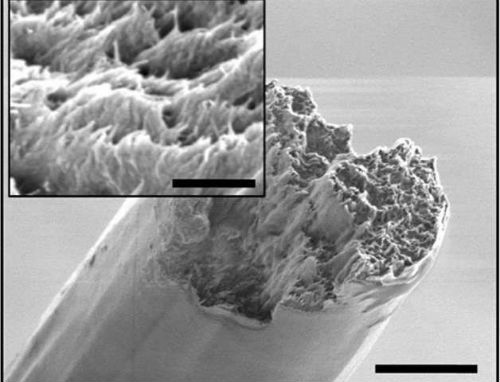|
NOVIDADES
Working with cellulose nanofibre (CNF), the essential building block of wood and other plant life, the researchers report that they have overcome the difficulty in translating the incredible mechanical properties of these nanofibres into larger, lightweight materials for use in airplanes, cars, furniture and other products. "The bio-based nanocellulose fibres fabricated here are 8 times stiffer and have strengths higher than natural dragline spider silk fibres, generally considered to be the strongest bio-based material," says corresponding author Daniel Söderberg, researcher at KTH Royal Institute of Technology. "The specific strength is exceeding that of metals, alloys, ceramics and E-glass fibres."  SEM image of the cross-section of the fibre, showing the aligned nanofibrils. Credit: KTH The Royal Institute of Technology
The reported progress results from the development of insights into the way physics controls structuring of components, such as CNF, at the nanoscale during fabrication. This understanding enabled a new process, which involves controlling the flow of nanofibres suspended in water in a 1 mm wide channel milled in stainless steel. Connecting flows of deionized water and low pH water help align the nanofibres in the right direction and enable the supramolecular interactions between CNFs to self-organize into a well-packed state where they are joined together. "This discovery is made possible by understanding and controlling the key fundamental parameters essential for perfect nanostructuring, such as particle size, interactions, alignment, diffusion, network formation and assembly," Söderberg says. Söderberg says the study opens the way for developing nanofibre material that can be used for larger structures while retaining the nanofibres' tensile strength and ability to withstand mechanical load. The process can also be used to control nanoscale assembly of carbon tubes and other nano-sized fibres. Measurements of the material were reported for tensile stiffness, 86 gigapascals (GPa), and for tensile strength, 1.57 GPa. Explore further: Silk proteins paired with renewable wood nanocellulose to produce the strongest artificial spider silk yet. More information: Near-Perfect Assembly of Nanoscale Building Blocks into Macroscopic Materials ACS Nano, dx.doi.org/10.1021/acsnano.8b01084. KTH Royal Institute of Technology. Posted: May 9, 2018. |
|||||||||||||||||||||||||